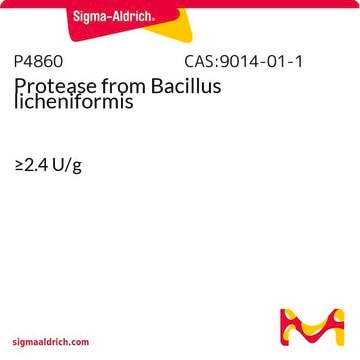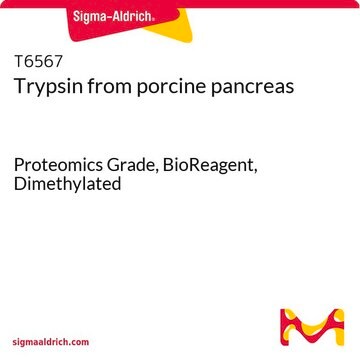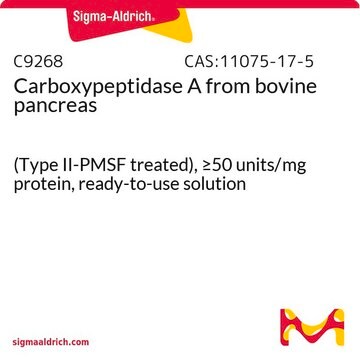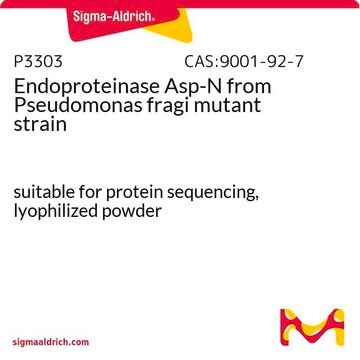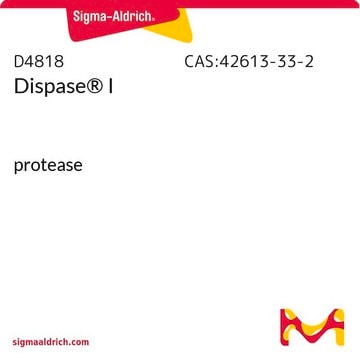The recommended assay buffer includes calcium: 10 mM sodium acetate buffer with 5 mM calcium acetate, pH 7.5 at 37°C. Prepare 100 ml in deionized water using sodium acetate trihydrate and calcium acetate. Adjust the pH to 7.5 at 37°C with 0.1 M acetic acid or 0.1 M NaOH. Additional information can be found at: https://www.sigmaaldrich.com/deepweb/assets/sigmaaldrich/product/documents/390/551/p1512enz.pdf
Wichtige Dokumente
P1512
Thermolysin from Geobacillus stearothermophilus
Type X, lyophilized powder, 30-350 units/mg protein (E1%/280)
Synonym(e):
Protease aus Bacillus thermoproteolyticus rokko, Thermophilic-bacterial protease
Größe auswählen
127,00 €
Versandbereit am09. April 2025Details
Größe auswählen
About This Item
127,00 €
Versandbereit am09. April 2025Details
Empfohlene Produkte
Biologische Quelle
Geobacillus stearothermophilus
Typ
Type X
Form
lyophilized powder
Spezifische Aktivität
30-350 units/mg protein (E1%/280)
Mol-Gew.
34.6 kDa by amino acid sequence
Aufgereinigt durch
crystallization
Versandbedingung
wet ice
Lagertemp.
−20°C
Verwandte Kategorien
Allgemeine Beschreibung
Anwendung
Qualität
Einheitendefinition
Physikalische Form
Angaben zur Herstellung
Signalwort
Danger
H-Sätze
Gefahreneinstufungen
Resp. Sens. 1
Lagerklassenschlüssel
11 - Combustible Solids
WGK
WGK 3
Flammpunkt (°F)
Not applicable
Flammpunkt (°C)
Not applicable
Persönliche Schutzausrüstung
dust mask type N95 (US), Eyeshields, Faceshields, Gloves
Hier finden Sie alle aktuellen Versionen:
Analysenzertifikate (COA)
Die passende Version wird nicht angezeigt?
Wenn Sie eine bestimmte Version benötigen, können Sie anhand der Lot- oder Chargennummer nach einem spezifischen Zertifikat suchen.
Besitzen Sie dieses Produkt bereits?
In der Dokumentenbibliothek finden Sie die Dokumentation zu den Produkten, die Sie kürzlich erworben haben.
Kunden haben sich ebenfalls angesehen
-
Does the enzyme need to add additional Ca2+ and Zn2+ to be activated?
1 Antwort-
Hilfreich?
-
-
Can this product be dissolved in PBS?
Can this product be dissolved in PBS?
1 Antwort-
There is no specific information available on the dissolution of thermolysin at a 50 mM concentration in PBS. PBS typically contains between 138 to 150 mM sodium chloride, which may or may not lower the overall solubility of the enzyme in PBS. If PBS is used, the user will need to determine if the enzyme fully dissolves in the solution or not.
For the complete enzymatic procedure, you can find the link here: https://www.sigmaaldrich.com/deepweb/assets/sigmaaldrich/product/documents/390/551/p1512enz.pdf
Hilfreich?
-
Aktive Filter
Unser Team von Wissenschaftlern verfügt über Erfahrung in allen Forschungsbereichen einschließlich Life Science, Materialwissenschaften, chemischer Synthese, Chromatographie, Analytik und vielen mehr..
Setzen Sie sich mit dem technischen Dienst in Verbindung.



